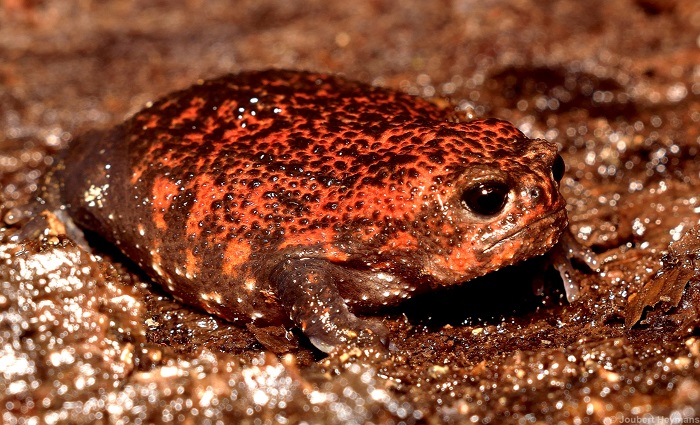Cover photo by J. Heymans.
Find the Strawberry Rain Frog in the FBIS database (Freshwater Biodiversity Information System) here.
Family Brevicepitidae
Identification

Landdroskop, Western Cape
Photo by Felicity Grundlingh
The female Strawberry Rain Frog attains a maximum length of 40mm. Males are much smaller, reaching just 25mm in length. The body is stout with short legs, and the snout is slightly more pointed than in other Breviceps species. The dorsal surface is reddish or pink to creamy white with many elevated black granules. The undersides are purplish with cream-coloured spots.
Habitat
The Strawberry Rainfrog occurs only in areas of high rainfall in uplands and mountains, both in Mountain Fynbos and in Afromontane Forest. Where mountains reach the coast, the species can occur at sea level (e.g. Betty’s Bay 3418BD; Grootbos 3419CB). The soils in these habitats are coarse, acidic sands derived from Table Mountain Sandstone, frequently admixed with peaty deposits.
Behaviour
Calling occurs both at night and during the day, usually during and after rain showers in winter and spring (June–November), but dense mist may be sufficient to stimulate calling. In Grootvadersbosch forest, males have been observed calling from above the ground, on top of logs (C.N. Spottiswoode pers. comm.; H. Braack pers. comm). In fynbos, the species has been found calling above ground in dense vegetation (M. Burger pers. comm), and from short burrows situated below low, covering vegetation (pers. obs.). Adhesive amplexus is employed during mating.
An amplexed pair, with a freshly laid egg mass comprising 24 eggs, was unearthed in Mountain Fynbos in the Boosmansbos Wilderness Area, on 22 October 1986 (D. McDonald pers. comm.). The pair was found in a chamber at the lower end of a network of tunnels covering an area of about 1 m2. Some branches of the tunnels ended blindly while others formed loops off the main tunnel leading to the egg chamber. The nest site was located on a cool, moist slope in sandy loam soil, covered by prostrate Cliffortia ferruginea. The eggs measured 6.5–7.8 mm (mean = 7) in diameter (L.R. Minter unpubl. data).

Grootvadersbosch, Western Cape
Photo by Trevor Hardaker
Little is known about the biology of this species. Studies of the differences in call structure and habitat partitioning between B. acutirostris and B. fuscus, in areas of sympatry, would be of particular interest.
Status and Conservation
The montane habitat of the Strawberry Rain Frog is generally little disturbed and occurs within a number of protected areas such as the Marloth Nature Reserve, Boosmansbos Wilderness Area, and Grootvadersbosch State Forest. This species is not threatened.
Distribution
The Strawberry Rain Frog is restricted to the southwestern ranges of the Cape Fold Mountains. The most westerly range in which it occurs is the Hottentotsholland Mountains (3318DD, 3418BB), the most easterly the Langeberg Mountains (3321CD); these ranges also represent the northern limits of the species. The map indicates a gap in distribution corresponding to the eastern Hottentotsholland and Riviersonderend mountains; this apparent absence requires confirmation. The species does not occur on the Cape Peninsula. The eastern extremities of its range overlap that of B. fuscus.

The atlas records are reliable, but sparse. Additional surveys may fill some of the gaps, especially in mountainous areas not adequately covered during the atlas project. The advertisement calls of B. acutirostris and B. fuscus are quite similar in structure (Passmore and Carruthers 1995; Channing 2001) although the call rate is distinctly faster in acutirostris (L.R. Minter pers. obs). In areas where both species may occur, aural records should have been supported by tape recordings of the calls, and by voucher specimens. This was seldom done, resulting in the possibility of some misidentifications.
Further Resources
The use of photographs by J. Heymans, Felicity Grundlingh, and Trevor Hardaker is acknowledged.
Strawberry Rain Frog Breviceps acutirostris Poynton, 1963
Other Common Names: Cape Short-headed Frog (Alt. English); Aarbei-blaasoppadda (Afrikaans)
Recommended citation format: Harrison, JA; Tippett, RM. (2025). Strawberry Rain Frog Breviceps acutirostris. Biodiversity and Development Institute, Cape Town. Available online at https://thebdi.org/2022/01/24/strawberry-rain-frog-breviceps-acutirostris/
This species text has been updated and expanded from the text in the
2004 frog atlas: Harrison, JA. (2004). Strawberry Rain Frog Breviceps acutirostris. In Minter LR et al 2004.
References:
Minter, LR; Burger, M; Harrison, JA; Braack, HH; Bishop, PJ; Kloepfer, D. (Editors). (2004). Atlas and Red Data Book of the Frogs of South Africa, Lesotho and Swaziland. Smithsonian Institution, Washington, and Avian Demography
Unit, Cape Town.
Carruthers, V; du Preez, L. (2017). Frogs of southern Africa: A Complete Guide. Struik Nature, Cape Town.
Channing, A. (2001) Amphibians of Central and Southern Africa. Protea Book House, Pretoria
Claus, B; Claus, R. (2002). Common Amphibians and Reptiles of Botswana. Gamsberg Macmillan, Windhoek.

